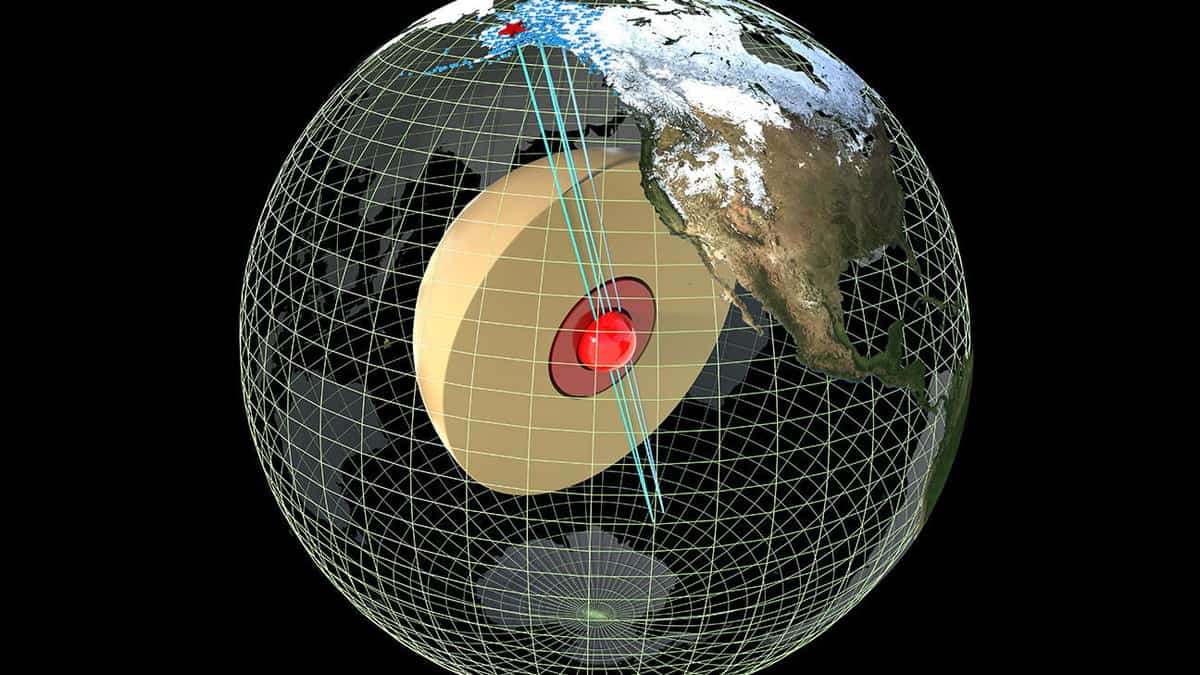Planet Earth is a treasure trove of enigmas, with one of the most intriguing being the mystery of its innermost core. While human-made mines can only delve a few kilometers deep, the secrets residing deep within our planet remain inaccessible. Nevertheless, scientists have managed to piece together a rough sketch of its internal composition.
What is the composition of our universe?
To comprehend this question, please proceed to the kitchen and retrieve a foam sponge commonly employed for dishwashing. Have you retrieved it? Excellent, for what you currently hold in your hands is a representation of the universe. Upon closer examination of the sponge’s structure under a magnifying glass, you will discern an abundance of interconnected open pores, devoid not only of walls but also comprised of bridges.
The Universe is akin to this sponge, with its lintels fashioned not from foam rubber but rather from clusters of galaxies. These lintels are not composed of planets or star systems, but rather of galaxies! Each of these galaxies consists of billions of stars orbiting a central core, with some spanning hundreds of thousands of light years in size. The typical distance between galaxies is approximately one million light years.
Scientists propose that iron makes up the Earth’s core with a high degree of certainty. It is estimated that iron constitutes about 80% of the core, although the exact proportion is still a matter of debate.
The primary evidence supporting this claim is the significant abundance of iron in the universe. Iron is one of the top ten most prevalent elements in our galaxy and is frequently found in meteorites. Given this abundance, iron is relatively scarce on the Earth’s surface compared to what would be expected. Hence, a hypothesis suggests that during the Earth’s formation 4.5 billion years ago, a majority of the iron ended up in the core.
What is the definition of the term “universe”?
The term “universe” originates from Old Slavic roots and is a modified version of the Greek word οἰκουμένη, which comes from the verb οἰκέω “to inhabit, to dwell in.” Initially, this word referred to the entire inhabited part of the world. Today, the Church maintains a similar meaning, as seen in the title of the Patriarch of Constantinople, who is referred to as “Ecumenical.”
The term “universe” is closely related to the word “universal,” and it signifies the concept of “all.”
Structure of Earth’s Core
In 1930, Danish seismologist Inge Lehmann made an observation that led to the understanding of Earth’s core. Lehmann discovered that P-waves, a type of wave, could travel through the core and be detected on the opposite side of the planet. This finding indicated that the core is divided into two layers. The inner layer, which starts approximately 5,000 kilometers below the surface, consists of solid matter. On the other hand, the outer layer is in a liquid state. In 1970, more advanced seismographs validated this concept by demonstrating that P-waves are able to pass through the core and even change direction in some cases. Despite these changes in path, the waves can still be detected on the opposite side of the planet.
What Lies at the Heart of the Cosmos?
The enigma of the central point of the Universe remains unresolved, shrouded in much perplexity. The quandary lies in the uncertainty of its existence. One might logically assume that, if there was indeed a cataclysmic Big Bang, which propelled innumerable galaxies into motion, it would be possible to determine the center of the Universe by tracing the trajectories of these celestial bodies and identifying their convergence point. However, the perplexing reality is that all galaxies are receding from one another at a nearly uniform pace, resulting in a remarkably homogenous view from any vantage point in the Universe.
Countless theories have been postulated, enough to drive any scholar to madness. The notion of a fourth dimension has even been entertained, yet, regrettably, the question remains shrouded in ambiguity to this very day.
When it comes to discussing the contents of the center of the Universe, it becomes a futile endeavor due to the lack of a definitive definition.
The Enigma Behind the Creation of the Earth’s Core
The precise mechanism by which iron managed to gravitate towards the core of our planet remains shrouded in mystery. Its journey is far from straightforward.
The majority of the Earth’s remaining mass consists of silicate rocks, posing a formidable barrier for molten iron attempting to penetrate through. Similar to how water forms droplets on a greased surface, iron congregates in isolated pockets where it becomes trapped, unable to disperse or dissipate.
In 2013, a potential answer was found by researchers at Stanford University in California, USA. Their focus was on investigating the effects of extreme pressure on both iron and silicates, similar to conditions found in the Earth’s core. By utilizing diamonds to apply pressure, the team successfully forced molten iron through the silicate material. This process revealed that the interaction between iron and silicates changes under high pressure, leading to the formation of a molten network. From this, we can infer that over the course of billions of years, iron slowly descended through the layers of rock until ultimately reaching the core.
What lies beyond the universe?
This is a fascinating inquiry, but just as uncertain as its predecessor. It remains unknown if the universe possesses any boundaries whatsoever. It is possible that there are none, or perhaps there are. It is conceivable that there exist other universes alongside ours, characterized by different properties of matter and distinct laws of nature and constants. Regrettably, no one can definitively answer such a query.
The predicament arises from our limited ability to observe the universe up to a distance of 13.3 billion light-years. Why is that? The explanation is quite simple: the universe is estimated to be 13.7 billion years old. Given that our observations are subject to a delay equivalent to the time it takes light to travel the corresponding distance, we are unable to perceive the universe prior to its actual inception. At this distance, we are witnessing a universe in its infancy…..
According to our school textbooks, the Earth is composed of three (or four) layers: the crust, mantle, and core, with the possibility of dividing the core into inner and outer layers. However, this simplified understanding fails to acknowledge the additional layers that scientists have identified in the Earth’s structure. In a recent study published in the journal Science, geophysicists from Princeton University (USA) and the Institute of Geodesy and Geophysics in China have discovered mountains and other topography within a layer located approximately 660 kilometers beneath the Earth’s surface, separating the upper and lower mantle.
“The ability to detect variations in elevation exceeding three kilometers at a depth of over 660 kilometers using seismic waves that traverse the Earth and return is truly remarkable,” remarks seismologist Christina Hauser, an assistant professor at the Tokyo Institute of Technology, Japan, who was not involved in the study.
The Earth’s structure is being examined by scientists using seismic waves that are created by earthquakes. At a depth of 660 kilometers, there are indications of underground mountains based on the roughness observed on the boundary layer. These powerful waves can penetrate deep into the Earth’s mantle, with earthquakes of magnitude 7.0 or higher causing shock waves to travel through the core and back to the opposite side of the planet. In order to gather data for their research, the scientists analyzed wave data from the 1994 earthquake in Bolivia, which had a magnitude of 8.2 and is the second most powerful earthquake ever recorded.
The scientists utilized the Tiger supercomputer cluster at Princeton University to model the intricate behavior of wave dispersion in the depths of the Earth. This simulation technique relies on a fundamental characteristic of waves: their capacity to alter direction and bounce. Similar to how light waves can be reflected or refracted as they pass through a prism, seismic waves travel directly through uniform rock but are reflected or refracted at the boundary of different materials. Consequently, their scattering provides information about surface irregularities and deep layers.
“The outcomes we acquired greatly astonished us. A more pronounced topography is present at the 660-kilometer boundary than in the Rocky Mountains or Appalachians, and it is just as intricate as what we observe on the surface,” the authors of the study noted.
A breathtaking view of the majestic Rocky Mountains captured from the stunning Rocky Mountain National Park located in the enchanting United States. Image credit goes to the talented photographer Stanislav Savin.
Although the statistical model failed to accurately measure the height of the mountains hidden beneath the surface, it did reveal the presence of unevenly distributed irregularities. These irregularities bear a similarity to the Earth’s crust, which boasts both smooth areas like the ocean floor and towering mountains. Additionally, the researchers delved deeper, exploring a layer situated 410 kilometers below the surface, specifically the upper portion of the mantle’s “transition zone.” Surprisingly, no topographic variation was discovered in this layer.
These findings beautifully demonstrate the advancements made in seismic instruments, enabling scientists to uncover new and unexpected properties within the layers of our beloved Earth.
Significance of the 660-kilometer boundary
The existence of irregularities at the 660-kilometer boundary plays a vital role in unraveling the mysteries of our planet’s formation. This boundary, which separates the upper and lower parts of the mantle, comprising around 84 percent of Earth’s volume, has long been a subject of debate among geoscientists. One key aspect of this debate has been understanding how heat is distributed throughout the mantle.
There is evidence from geochemistry and mineralogy that suggests the upper and lower mantle have distinct chemical compositions, indicating that they do not mix thermally or physically. However, recent findings propose that the smoother regions observed at the 660-kilometer boundary could be the result of extensive vertical mixing, while the presence of mountainous regions suggests areas where mixing does not occur.
What could have caused the significant difference in the composition of the layers? According to scientists, the reason is the sinking of rocks that were once part of the Earth’s crust. Geophysicists have long debated what happens to seafloor slabs that collide with the mantle in subduction zones all over the world. Researchers suggest that the remnants of these ancient plates may now be located just above or just below the 660-kilometer boundary.
“The field of seismology becomes fascinating when it allows us to gain a better understanding of the internal mechanisms of our planet in terms of both space and time,” the authors of the study conclude.
What other information do we possess regarding the universe?
We possess an extensive amount of knowledge, as well as some uncertainty! We are aware of relic luminescence, cosmic strings, quasars, black holes, and numerous other phenomena. Certain aspects of this knowledge can be substantiated and proven, while others are solely based on theoretical calculations that cannot be empirically verified. Additionally, there are elements that exist purely within the realm of imagination, originating from pseudo-scientists.
However, one undeniable truth remains: there will never be a moment when we can confidently declare, “Phew! We have exhaustively explored every question. There is nothing left to discover!”
The Earth’s Weight
An effective approach is to consider the weight of the Earth. We can approximate the weight of our planet by observing the gravitational impact it has on objects situated on its surface. It appears that the Earth has a weight of 5.9 sextillion tons. That equates to the numerical value 59 followed by 20 zeroes. Furthermore, there is no evidence of anything of such immense weight on the Earth’s surface.
The density of materials found on the Earth’s surface is significantly lower compared to the average density of a planet. This implies that there must be something with a considerably higher density present within it.
Moreover, the majority of the Earth’s weight should be concentrated towards its core. Consequently, the subsequent step is to identify the heavy metals that comprise its core.
What are the locations of the Earth’s chakras?
Every one of these centers holds a unique significance and is regarded as sacred by one or more religious traditions. These sites play a crucial role in the functioning of the Earth as a whole.
The energy centers bear a resemblance to the well-known primary chakras found within the human body and serve as potent hubs for subtle energy.
There are a total of seven of these locations on our planet, each responsible for the well-being of the Earth.
First chakra muladhara
Mount Shasta is located in North America, specifically in the state of California. It is widely known as the root chakra, serving as the foundation for the Earth’s entire energy system.
The main objective of this chakra is to generate a continuous flow of life energy, which can only take shape after undergoing transformation in other sacred centers across the Earth.
This particular location is associated with the lower body, encompassing the hips and legs of an individual.
Lake Titicaca, located on the border between Bolivia and Peru, is renowned as the second energy hub on Earth. To be more specific, it is not just a mere lake, but a bedrock within the heart of this vast body of water. Its primary function is to facilitate the emergence of novel species and foster evolutionary processes.
Titicaca can be likened to the core of the planet’s creative and sexual energy, akin to the abdominal cavity.
Manipura – The Third Chakra
Australia has become home to Manipura, the third chakra. This country boasts two sacred locations: the red monolith Uluru (formerly known as Ayers Rock) and Kata Tjuta (Mount Olga). Comprised of colossal red rocks, both sites hold great significance for the locals and are deeply ingrained in the legends and folklore of this vast continent.
The purpose of Manipura is to preserve vitality and is associated with the solar plexus.
The anahata chakra, also known as the fourth chakra, is located in the United Kingdom. Specifically, it can be found in the towns of Glastonbury and Shaftesbury, near Somerset. This sacred site is often associated with tales of the Holy Grail and the sacred Spear of Purpose.
In the town of Glastonbury, UK, the purpose of this place is to create an environment for the interaction of different forms of life, compassion, and love.
The anahata chakra is closely linked to the circulatory system, heart, and lungs.
The fifth chakra is vishuddha
Vishuddha, the fifth chakra, is not specifically associated with a particular location. It is believed that this sacred place is represented by the Great Pyramid (the only man-made chakra), Mount Sinai (known as the site where Moses received divine revelations), and the Mount of Olives (where the mystical Golden Gate can be observed).
These locations are connected to three major religions – Islam, Christianity, and Judaism.
The purpose of this place is to facilitate a dialogue with the Spirit of the Earth, the voice of the planet.
The fifth chakra is associated with the throat.
This chakra is not fixed in one location and changes its position in accordance with the Earth’s rotation of the Earth. Many esotericists speculate that it is currently situated in Europe.
The objective of this sacred space is to safeguard centuries of ancient wisdom and subsequently utilize that knowledge for a new phase of evolutionary progress.
The sixth chakra is commonly referred to as the third eye.
Subterranean Existence
The depths of the Earth remain untouched by sunlight, creating an environment shrouded in darkness. For most individuals, being in such a place would elicit feelings of discomfort, if not outright unease. It is no wonder that some may even lose their sanity, as darkness engulfs them from all sides and every sound reverberates through the abyss.
However, life thrives beneath the surface. Where there is water, there are living organisms, and there is an abundance of water in the depths of our planet. Entire underground lakes and rivers flow, providing a sanctuary for diverse forms of life.
Ewen Roberts is the photographer of the captivating image featured above. You can find the original photo here (the photo has been modified).
The world beneath our feet is an enchanting realm. It captivates with its extraordinary appearance, its somberness, its foundational, steadfast, and at times delicate nature. I cannot fathom the experiences of experienced spelunkers as they descend into the depths of the Earth. However, novice spelunkers, delving into this domain of darkness, encounter a rush of adrenaline, curiosity, a yearning to be an explorer… and a fear that lurks deep within. After all, everyone understands that if something were to happen, they could potentially be entombed beneath the ground forever. Though the likelihood of such an event is slight. And even in the event of a collapse, there is always an exit. Moreover, given that many passageways are carved by water, they will inevitably lead to somewhere.
The number of aspiring cave explorers is continuously increasing. Numerous individuals are eager to embark on an extraordinary adventure and delve into the depths of the earth. As a result, previously unknown caves are being unearthed, unveiling fascinating revelations about our world. However, it is worth noting that the current record for the deepest cave stands at a mere 5 kilometers. While this may seem like a considerable depth, especially when one is actually descending, it pales in comparison to the potential depths that have yet to be explored. Imagine descending 10 kilometers below the surface. What mysteries lie within those uncharted territories? Would we encounter the same underground rivers, caverns, and passageways? Perhaps we may even stumble upon undiscovered life forms thriving in the darkness.

Throughout history, mankind has always held a deep fascination with the inner workings of our planet. It has been hypothesized that at the very core lies a central core, although this has yet to be definitively proven. Instead, we must rely on the calculations and assumptions made by scientists to gain our understanding.
Over time, scientific advancements have gradually provided more concrete evidence to support these theories. In ancient times, when the belief in a flat Earth was prevalent, it was thought that the depths of the planet housed the souls of the deceased, creating a separate realm altogether.
In the realm of modern science, it is widely believed that our planet possesses a core, characterized by a predominantly dense structure composed of metallic materials, enveloped by a fiery sea of molten magma. Some researchers even propose that this core is divided into three distinct layers, with the third layer being an even denser metallic formation, hitherto unknown.
It is important to note, however, that this theory lacks practical confirmation and relies solely on the assertions of geophysicists and geochemists, who derive their conclusions from indirect evidence and intricate calculations. The initial claims regarding the existence of a core were first put forth in the late 19th century, and while they were substantiated by theoretical calculations, they lack practical substantiation.
The presence of scorching magma deep within the Earth is attested to by the eruption of volcanoes, which unleashes streams of molten lava. Furthermore, during seismic events, seismographic instruments record data that strongly suggests the presence of a high-density substance within the Earth.
Exploratory Efforts to Uncover the Secrets of the Planet
Multiple research endeavors have been conducted to investigate the Earth’s crust composition. Understanding the precise makeup of the planet would enable scientists to predict cataclysmic events, ultimately saving countless lives and structures.
American scientists in Louisiana were the first to venture into the depths of the planet. They drilled a hole reaching a staggering depth of 9 kilometers. However, as the well emitted a strong hydrogen sulfide odor, the scientists swiftly took precautions by filling the hole with concrete, recognizing the potential danger of the experiment.
In the Arkhangelsk region, a well of comparable depth was drilled, resulting in a gush of gas mixed with oil. The resulting intense fire proved to be quite challenging to extinguish. As a result, a massive natural formation composed of frozen rock emerged on the surface.
Meanwhile, on the Kola Peninsula, scientists managed to drill to a depth of 12 kilometers, although this endeavor did not yield any visual evidence or core samples from within the Earth. Researchers have yet to delve deeper, leading some in the scientific community to believe that more advanced equipment and technology are required for such exploration.
Alternative interpretation of the Earth’s composition
The prevailing understanding of the Earth’s structure, which posits the existence of a core within, is widely accepted and supported by numerous evidences. However, there exists a theory proposed by certain scientists that remains unproven due to a lack of empirical data.
Scientist Obruchev has put forward the notion that the Earth is hollow and harbors a distinct civilization within its inner space. He anticipates that humanity will one day uncover an entrance to this subterranean realm, thus obtaining concrete validation of his hypothesis.


Thanks for taking the time to read this! Don’t forget to share this post on your social media platforms, as it plays a crucial role in promoting the website. Make sure to visit Besarte.ru more frequently so you don’t miss out on our latest articles.

- Personal investment account
- Investing for individuals residing outside the Russian Federation
- Forex broker licensed by the Central Bank of the Russian Federation
- Forex broker licensed by the European Union
- Business current account with favorable terms
- Advertising service for businesses
- Turnkey SEO website promotion
- Organic backlinks for your website
- Content creation for your website
- Top hosting services for your website
- Make money by writing articles
- Freelance platform for professionals
- Exclusive online dating club
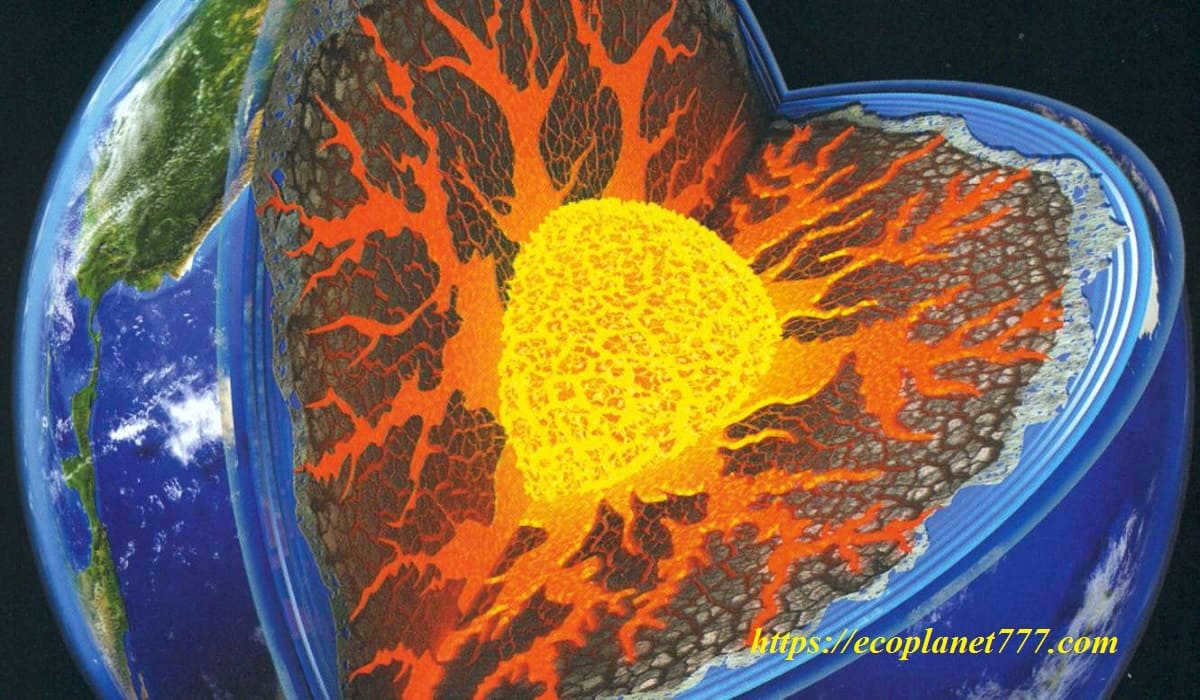

This is the total amount of water in the earth’s crust. It encompasses all the waters of the seas and oceans, lakes and rivers, as well as groundwater and all the ice and snow from glaciers. Water in the hydrosphere experiences constant exchange. It never remains in one location. This is the natural water cycle.
Considering that the seas and oceans cover three-quarters of the Earth’s surface, their significance on a planetary scale cannot be overstated. It is thanks to the hydrosphere that the planet has its characteristic pleasant blue hue.
In bodies of water, numerous beneficial substances exist in a dissolved state. Due to the forces associated with the Earth’s rotation, lunar gravity, and winds, there are continuous movements of water masses, including ocean currents, various types of waves, and tides.
The Earth’s atmosphere: a unique environment
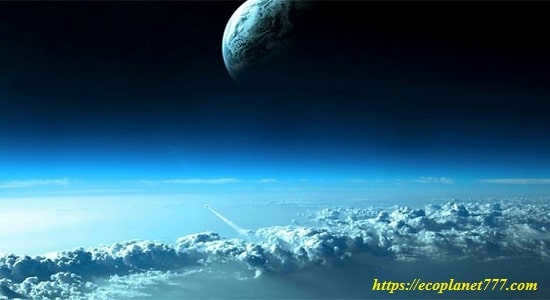
The Earth’s atmosphere is a vital gaseous layer that envelops the entire planet. Just like water, it is crucial for the survival of all living organisms. Oxygen, in particular, is an essential gas necessary for life to exist. Additionally, numerous other gases play a role in filtering solar radiation, which can be harmful to living beings.
Our planet’s atmosphere is divided into various layers, each characterized by its unique thickness, composition, and functions.
- Troposphere – This layer is situated directly above the solid surface of the Earth. It is of utmost significance as it is the very place where we live and where meteorological phenomena like rainfall occur.
- The layer above the troposphere, known as the stratosphere, extends approximately 10 kilometers high. This particular layer is responsible for shielding the Earth from harmful UV rays and is commonly referred to as the ozone layer.
- Higher up in the atmosphere is the mesosphere, which also contains a certain amount of ozone.
- The thermosphere, aptly named due to the influence of solar radiation, experiences temperatures as high as 1500°C. Within this layer lies the ionosphere, where numerous atoms lose electrons and transform into ions, resulting in the mesmerizing phenomenon of the northern lights.
The biosphere refers to the collective ecosystems that exist on our planet, rather than being a distinct layer. It encompasses all living organisms that inhabit the Earth, making it an integral part of the Earth’s crust, hydrosphere, and atmosphere.
Fascinating Earth facts! The pressure at the Earth’s core is millions of times greater than at its surface.
The characteristics that define the biosphere are known as biodiversity. This encompasses the vast array of different life forms found on Earth. Furthermore, there exists a delicate balance between all components of the biosphere, which is crucial for the proper functioning of its elements.
It has been widely accepted since the middle of the previous century that the solid portion of planet Earth is stratified into concentric layers: crust, mantle, and core.
Understanding the Earth’s structure has posed a challenge due to the inaccessibility of the deep zones. As a result, geologists have employed various methods to gather data and determine the Earth’s structure and composition. These methods have traditionally been classified as direct and indirect.
- Data obtained through indirect methods are acquired by analyzing variations in certain geophysical variables. The most informative data are obtained by investigating detected anomalies in the gravimetric and magnetic fields. However, the most intriguing information presented is the data obtained through seismology, the scientific study of seismic waves.
The internal forces of the Earth generate movements that are observable even from the exterior. Rapid movements result in earthquakes, while slow movements give rise to folds such as those found in mountain formation.
Fascinating Earth facts! One of the primary components of the Earth’s core is sulfur, with 90% of the Earth’s sulfur located within its core.
The rapid rotation and metallic core of the Earth generate a magnetic field that, in conjunction with the atmosphere, shields us from the hazardous radiation emitted by the Sun and other celestial bodies in the cosmos.
When observing the Earth from an external perspective, it can be classified into five distinct conventional segments:
The Atmosphere (outer layer)
The Atmosphere is the gas shell that surrounds our planet. It has a thickness of over 1100 km, with the majority of its mass concentrated in the lower layers (5.6 km).
The Hydrosphere
The Hydrosphere primarily consists of the oceans, but it also includes all of the world’s water surfaces such as seas, lakes, rivers, and groundwater. The average depth of the oceans is 3,794 meters, which is more than five times the average height of mountains on the continents.
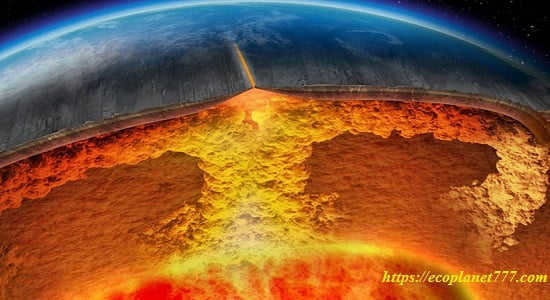
The lithosphere, which extends to depths of up to 100 km, primarily consists of the Earth’s crust. It is composed of various rocks that have an average density 2.7 times that of water. These rocks are primarily made up of 11 chemical elements, accounting for 99.5% of their mass.
Oxygen is the most abundant element within the lithosphere, followed by silicon, aluminum, iron, calcium, sodium, potassium, magnesium, titanium, hydrogen, and phosphorus. Additionally, there are 11 other elements present in smaller amounts, each constituting less than 0.1% of the lithosphere’s mass. These elements include carbon, manganese, sulfur, barium, chlorine, chromium, fluorine, zirconium, nickel, strontium, and vanadium. It is worth noting that these elements are typically found in the lithosphere as compounds rather than in their elemental form.
Consequently, the lithosphere is composed of merely two sections (the crust of the Earth and the upper mantle) that are further divided into approximately twelve stiff tectonic plates. The upper mantle is distinguished from the Earth’s crust by a seismic discontinuity known as the Mohorovicitch discontinuity, and from the lower mantle by a zone of low strength called the asthenosphere. The pliable and partially melted rocks of the asthenosphere, which is approximately 100 km thick, enable the movement of continents across the Earth’s surface and the opening and closing of oceans.
The garment
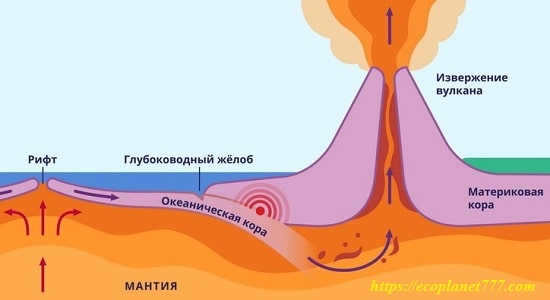
The mantle is located beneath the Earth’s crust and extends to a depth of 2,900 km. With the exception of the asthenosphere, which is a more fluid region, the mantle is primarily solid. Its density increases as you go deeper, ranging from 3.4 to 6.0. The upper mantle is composed of iron and magnesium silicates, such as olivine, while the lower mantle consists of a mixture of magnesium, iron, and silicon oxides.
Essence
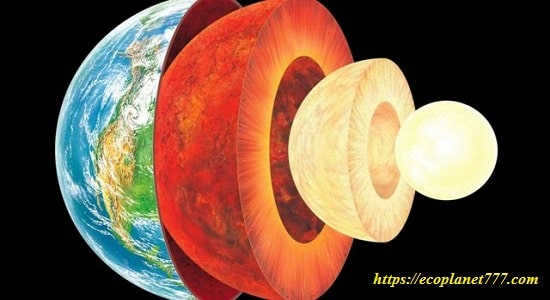
The Earth’s center consists of two layers. The outer layer, which is approximately 225 km thick, has an average relative density of 10 kilograms per cubic meter. This layer is believed to be rigid, with variations in its surface topography. On the other hand, the inner core, with a radius of about 1275 kilometers, is solid. Both layers of the Earth’s center are primarily composed of iron, with small amounts of nickel and other elements. The temperature at the middle of the core reaches a scorching 6650°C, and its average density is 13.
Fascinating facts about the Earth! The geothermal gradient is approximately 25°C per 1 kilometer of depth. In simpler terms, the Earth’s temperature increases by 25°C for every kilometer of depth.
The solid part of the planet is comprised of various concentric layers, with the inner core constantly emitting high levels of heat outwards. This heat is generated by the decay of radioactive elements such as uranium. The majority of the Earth’s heat energy is transported to the surface through convection currents in the mantle.
The Earth’s solid outer layer is known as the crust
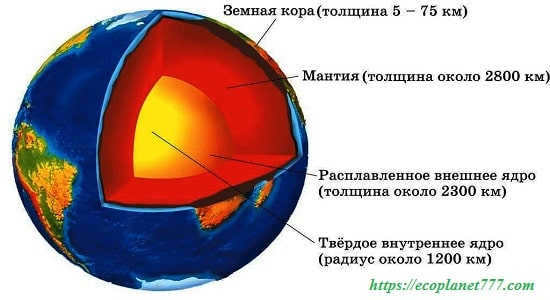
The Earth’s planetary crust is composed of a thin layer consisting of rigid plates that rest atop the mantle. These plates, along with the mantle, combine to form the lithosphere and sit atop the asthenosphere, which is a layer of hot, viscous material that occasionally erupts through fissures to create volcanoes.
As one moves towards the Earth’s center, both density and pressure increase. The heaviest materials, such as metals, reside at the base and remain in a molten state due to the presence of heat and vigorous movements. The inner core, however, is solid.
The crust serves as the rocky uppermost layer that encompasses the planet. Its thickness varies depending on the particular region being examined. For instance, in oceanic regions, the crust can measure up to 3 kilometers in thickness, while in more rugged and mountainous areas like the Andes, the crust can exceed 60 kilometers in depth.
The oceanic mantle is composed of iron and magnesium silicates, while the continental crustal mass is made up of acidic rocks containing sodium, potassium, and aluminum silicates. The distinction between the crust and the underlying mantle can be identified by their unique compositions and the variation in seismic velocity between them.
The Earth’s Mantle: A Unique Layer of Hot Rock
The mantle, an upper shell of the Earth, is a dense layer of hot rock situated between the core and the crust. It spans a thickness of approximately 3,000 kilometers and is primarily composed of silicates.
This layer, known as the mesosphere, exhibits varying densities throughout, with higher density closer to the Earth’s interior and lower density as it nears the surface.
As one delves deeper into the Earth’s core, the mantle experiences increased heat and pressure, resulting in changes to its physical properties and chemical composition. The extreme temperatures in certain regions of the mantle even facilitate a subduction cycle, where heavier materials from the planetary crust melt and exchange matter and energy.
The Earth’s mantle, much like the core, has never undergone direct study. Its depths are too inaccessible for human exploration, thus most of our understanding of it comes from indirect methods such as seismological analysis or sampling in accessible areas, both on land and underwater.
Distinctive features of the Earth’s mantle
The primary characteristic of the mantle is its status as the thickest layer of the planet, extending approximately 2,900 kilometers towards the core. Occupying roughly 85% of the Earth’s total volume, the mantle plays a significant role in the seismic activity observed on the planet’s crust. The upper layer of the mantle exhibits greater motion compared to the lower layer, though this behavior is subject to various chemical conditions present within.
The mantle is primarily composed of silicates and other lighter minerals, with oxygen being the most abundant element at 44.8%. Magnesium makes up 22.8% of the mantle, followed by silicon at 21.5%, iron at 5.8%, calcium at 2.3%, and aluminum at 2.2%. The mantle also contains minor elements such as sodium and potassium.
Due to the immense pressure it experiences, the mantle remains in a solid or liquid-viscous state, with temperatures ranging from 600 °C to 3500 °C as it gets closer to the Earth’s core.
The mantle serves several important roles in the Earth’s structure: it acts as a thermal insulator, maintaining a cold and stable crust, and it also facilitates the formation of new crust through the release of magma during tectonic plate separation.
The Earth’s mantle is comprised of two main regions:
- The upper mantle, which extends from the Earth’s crust to a depth of approximately 255 kilometers. This region is primarily solid, but contains pliable areas that allow for tectonic activity. Within the upper mantle, two distinct regions can be identified: the lithosphere, which is solid, and the asthenosphere, which is viscous and semi-solid.
- The lower or inner mantle, situated below 660 km deep and reaching depths of 2700 km, is a region characterized by greater density and higher temperatures compared to the upper layer. It is predominantly solid and significantly less malleable than the upper mantle. The lower mantle begins at the transition zone following the upper mantle and continues until the Gutenberg boundary. The exact composition of this region remains a topic of discussion among scientists. Between these two regions lies the transition zone, also known as the intermediate zone, which extends from depths of 400 to 600 kilometers. In this zone, rocks undergo high-pressure processes that cause significant changes in their chemical composition and largely impede the exchange of matter between the upper and lower layers of the mantle.
Mantle convection refers to the movement of the mantle and the transfer of heat from the Earth’s core to the lithosphere. The mantle experiences heating from the bottom to the top and cooling from the top to the bottom.
Volcanoes are formed due to the movement of hot magma into the lithosphere at plate boundaries and hot spots, driven by convection currents. These currents also facilitate the movement of cooler and denser material from the crust into the Earth’s interior through subduction.
The Significance of Earth’s Mantle
The mantle holds great importance in the field of geology as it constitutes the majority of the planet. Additionally, it is responsible for most of the gravitational force experienced on the planet’s surface.
Furthermore, the mantle plays a crucial role in the creation of materials that are utilized for various purposes on the Earth’s surface.
The mantle transition zone acts as a barrier, limiting the exchange of matter between the upper and lower mantle. This process prevents the lithosphere layers from sinking too deep into the Earth.
The mantle serves as a protective barrier, ensuring that the scorching core remains shielded, preventing any potential destruction of the planet.
An examination of the Earth’s core composition
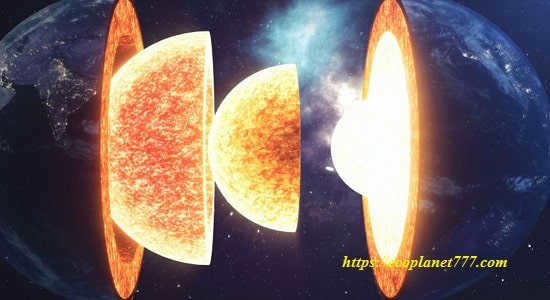
The Earth’s core is located at the center of the planet and is comprised of two distinct parts: the inner core and the outer core. These two layers have different compositions, which is why they are considered separate entities. The inner core, with a radius of 1220 kilometers, is solid in nature. On the other hand, the outer core, which surrounds the inner core, is semi-solid and has a radius of up to 3,400 kilometers.
The Origin and Formation of the Earth’s Core
Scientists hypothesize that the Earth’s core was not present when the planet first formed over 4.5 billion years ago. Instead, they believe that the early Earth was a homogeneous, hot rock. As the planet formed, thermal energy and radioactive decay processes intensified, causing the rock to heat up even more. Eventually, the rock reached a critical temperature, known as the melting point of iron (1538°C), which marked a significant turning point in the Earth’s history – the iron catastrophe.
Fascinating Facts about the Earth! The pressure at the planet’s core is approximately 3.6 million atmospheres.
Earth’s core composition
The Earth’s core is made up of heavy metals, unlike the crust and mantle which are rich in minerals. The main components of the core are iron and nickel.
In addition to iron and nickel, there are other elements that dissolve in liquid iron and are known as siderophiles. These siderophiles are sparsely distributed in the upper layers of the planet, which is why many of them are considered “precious metals” such as gold, platinum, and cobalt.
The Earth’s core temperature
While we have knowledge that the core is the hottest region of our planet, accurately determining its temperature poses a challenge. The temperature of the core varies due to factors such as pressures, the speed of Earth’s rotation, and the varying composition of core elements.
It is commonly accepted that the temperature within the Earth’s core or its central region spans from 4400°C to 6000°C.
Unique characteristics of the Earth’s core
The decay of radioactive elements is the primary source of thermal energy in the Earth’s core.
The core is an integral part of the geosphere and is composed of two distinct layers: the outer core, which borders the mantle, and the inner core. The Bullen Gap serves as the boundary between these regions.
The outermost region of the Earth’s core is situated at a depth of nearly 3000 kilometers. To put this into perspective, the Kola Ultra Deep in Russia, the deepest well ever drilled by humans, reaches a depth of only 12.3 kilometers.
The outer core
With a thickness of approximately 2.2 thousand kilometers, the outer core is composed of liquid iron and nickel. The temperature of this region ranges from 4500°C to 5500°C.
Due to its low viscosity, the liquid metals in the outer core are easily deformable. This results in strong convection, which plays a crucial role in the formation and maintenance of the Earth’s magnetic field.
The Bullen Gap, which marks the boundary between the liquid outer core and the solid inner core, is the hottest part of the outer core. It reaches temperatures of nearly 6000°C, equivalent to the surface temperature of the Sun.
Core’s Innermost Region
The innermost region of the Earth is extremely hot and extremely dense, consisting primarily of iron. With a radius of approximately 1220km, this region reaches temperatures as high as 5200°C.
Despite the fact that the temperature in the inner core surpasses the melting point of iron, it remains in a solid state due to the immense pressure that prevents the metal from liquefying. The pressure and density of the material are so immense that the iron atoms simply cannot transition to a liquid state.
Exploring the Structure of the Earth: Various Methods
By utilizing various techniques to explore our planet, scientists have discovered that the Earth’s interior is far from being uniform. There are several distinct methods used to study the Earth’s structure:
Direct Approaches
These methods involve observing and examining the properties and formations of rocks found on the Earth’s surface. By directly accessing these rocks, scientists can fully understand their characteristics. Laboratory analysis allows for a comprehensive study of the rocks that make up the upper layers of the Earth’s crust. However, a significant limitation is that this method can only be applied to rocks extracted from depths of approximately 10 kilometers.
Methods of Inference
Scientists employ various techniques to infer information about the Earth’s interior. While direct access is not possible, researchers can learn more about the planet by studying and analyzing properties such as density, gravity, and seismic waves. Even the study of meteorites can provide insights into the internal structure of the Earth.
One of the primary methods of inference used to determine the planet’s internal structure is the analysis of seismic waves. By studying the velocity and trajectory of these waves, scientists can gain a more detailed understanding of the physical and structural aspects of the Earth. This is because the oscillation of seismic waves is influenced by the properties and composition of rocks.
P.S.
If you found this information helpful and enjoyable, please share it on social media with your friends and acquaintances. By doing so, you will be supporting our project called “Ecology of Life” and making a contribution to the preservation of the environment!
The “Ecology of Life” project is designed for those who value and wish to protect their well-being and the planet we call home! We have a deep appreciation for nature and a sustainable way of life!
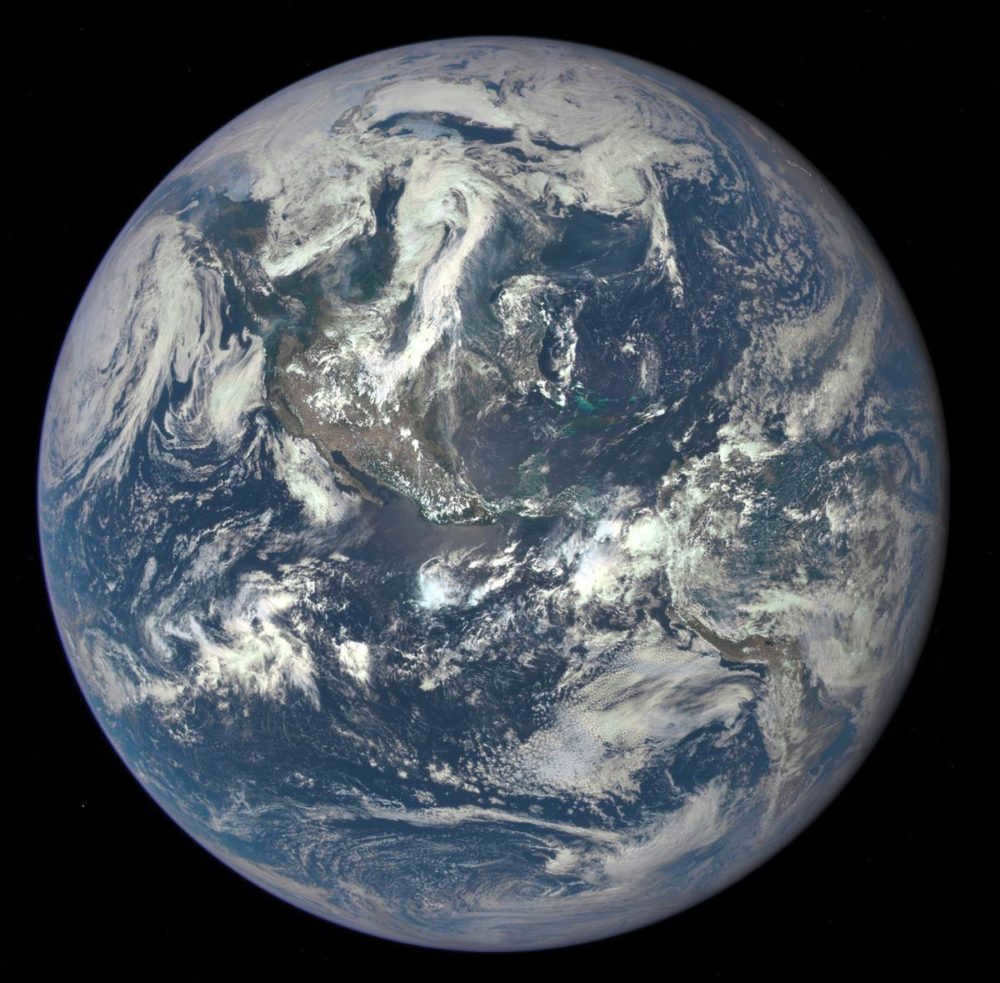
The Earth’s history has been filled with turmoil, making it a far cry from the cozy and welcoming place it is today. Our planet is constantly evolving, with continents and oceans slowly shifting and the climate undergoing changes. The biosphere, which encompasses all living organisms, is also in a state of constant flux. In recent millennia, the Earth has experienced the profound impact of human activity, but that is a topic for another discussion. Before delving into that, let’s first explore a general overview of the Earth’s position in the Universe and its location within our galaxy.
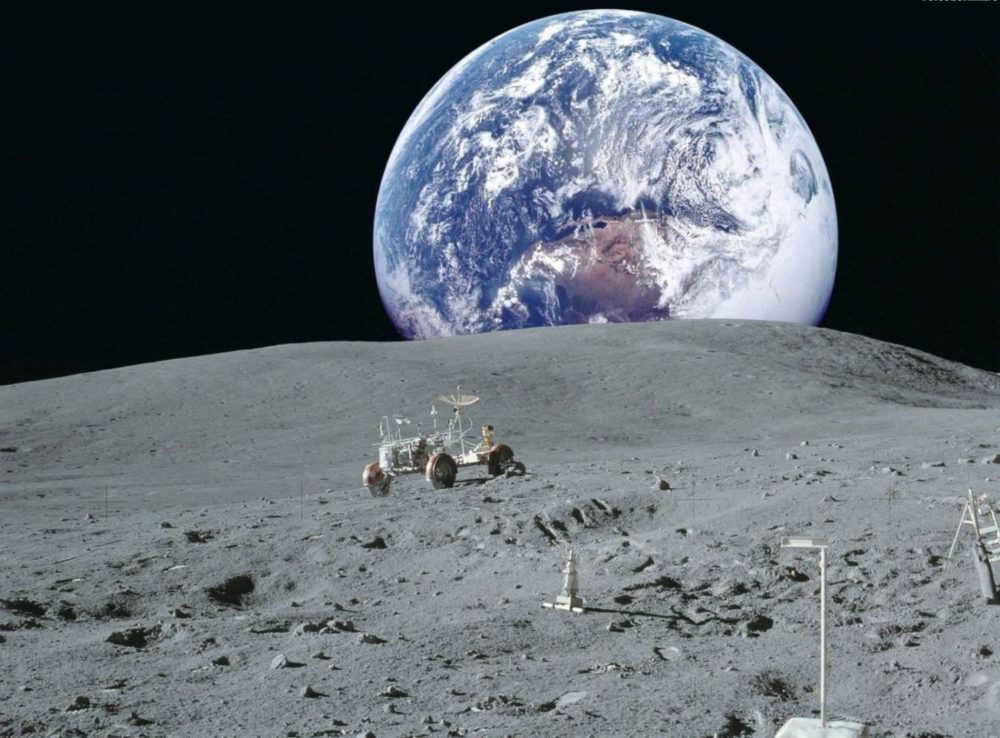
Earth’s Position in the Vastness of Space
Our planet Earth is situated in a vast cosmic neighborhood known as the Milky Way galaxy. The Milky Way is a magnificent spiral galaxy that is home to approximately 200 billion stars of various sizes and types. It gracefully spins and orbits around its central core.
Contrary to popular belief, the Sun is not positioned at the center of the Milky Way. It resides within one of the arms of the galactic spiral, known as Orion’s Belt. The distance from our Sun to the galactic center is a staggering 26,000 light years.
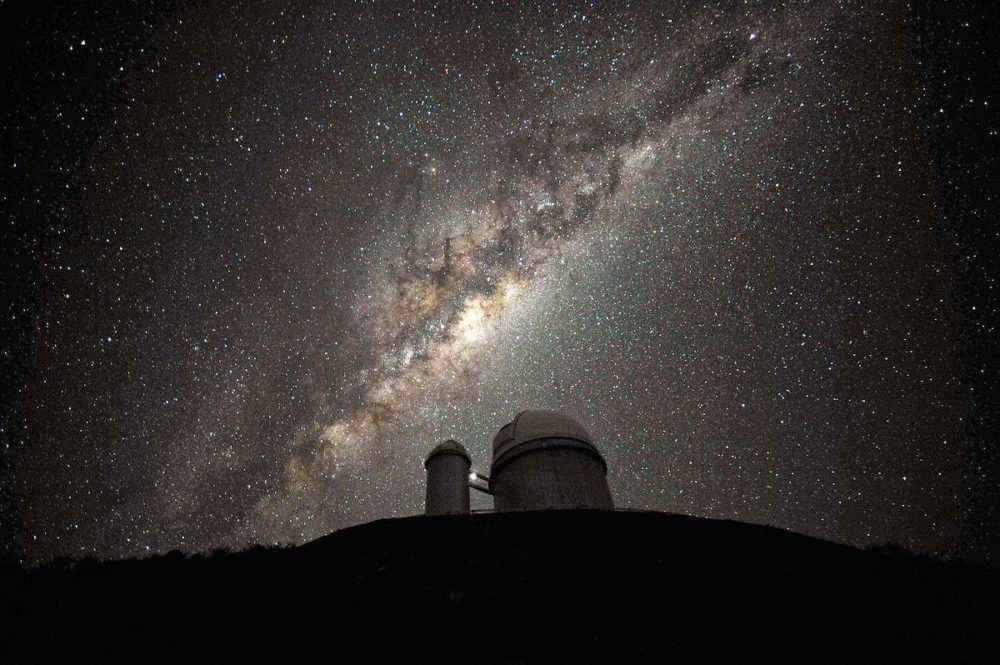
Our solar system is unique because the Sun is the only star in it. The Sun is classified as a yellow dwarf star and is predominantly made up of hydrogen and helium. It does contain small amounts of other elements as well. In terms of cosmic standards, the Sun is considered to be a fairly common and typical star. There are countless stars like it throughout the visible universe. Deep within the core of the Sun, thermonuclear reactions occur constantly, converting hydrogen into helium and releasing an immense amount of energy. This energy is what makes life on planet Earth possible.
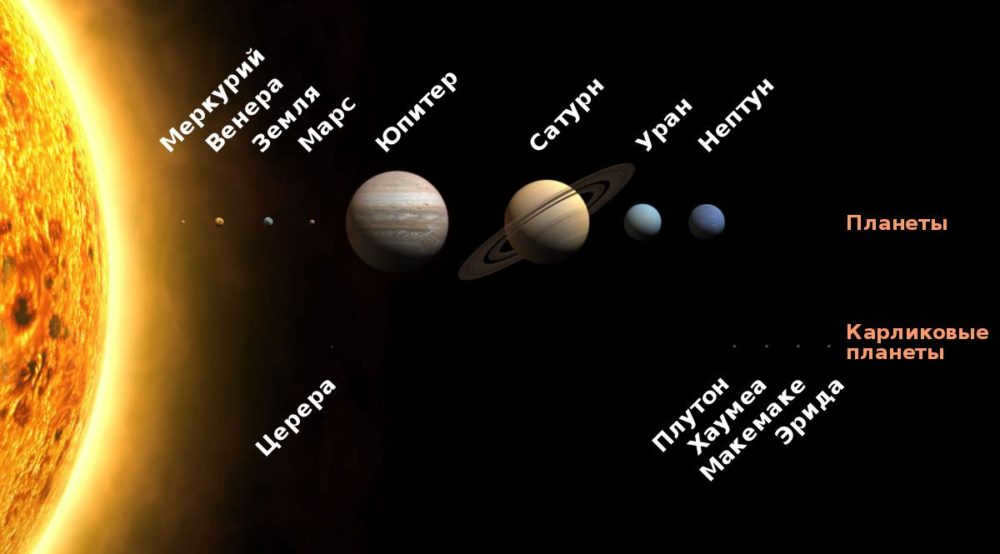
The movement of the planets takes place in nearly circular paths forming a flat disk known as the ecliptic plane. The unique characteristics of Earth’s rotation and its axial tilt are responsible for the changing seasons.
Earth’s neighboring planets include Venus and Mars. Human-made spacecrafts have successfully landed on these celestial bodies, and there is currently ongoing exploration of Mars. Multiple nations have plans to send astronauts to the red planet. The planet closest to Earth is Venus, a barren and scorching sphere where surface temperatures can reach the melting point of lead.
Our planet, Earth, is accompanied by a single natural satellite known as the Moon. It holds the distinction of being the only celestial body that has been explored by humans. The Moon is a solid sphere, adorned with numerous craters, and it orbits the Earth in an elliptical path. The Moon’s rotation plays a crucial role in the ebb and flow of tides in the oceans of our planet. Recent discoveries have even revealed the presence of water on this lunar entity, leading to speculation that it may have once supported life, much like our own Earth.
Recently, there has been a lot of buzz about the Moon and Mars in the realm of space exploration. It is predicted that humanity will soon be capable of constructing a permanent station on our celestial neighbor, the Moon, and even sending an expedition to the red planet, Mars. These remarkable advancements are expected to take place within the upcoming decade. In this exciting endeavor, scientists are eager to uncover any signs of organic life that may exist on Mars.
Overview of Earth
The planet Earth is a relatively small rocky sphere with some areas covered by water. It occupies the third position from the Sun in our solar system. Have you ever wondered about the actual dimensions of our planet?
Earth has an average radius of 6,371 kilometers and a total surface area of 510,072 million square kilometers. Out of this, approximately 361,132 million square kilometers are covered by water, while the remaining 148,940 million square kilometers are land. The diameter of Earth is measured at 12,742 kilometers.
Contrary to popular belief, Earth is not perfectly spherical. Instead, it takes the shape of a spheroid, slightly flattened at the poles and elongated near the equator.
The Earth is primarily made up of various elements, with iron being the most abundant at 32.1%. Oxygen makes up 30.1% of the planet, followed by silicon at 15.1% and magnesium at 13.9%. Interestingly, the majority of iron, about 88%, is located in the Earth’s core. On the other hand, the Earth’s crust contains the highest concentration of oxygen, accounting for 47% of its composition.
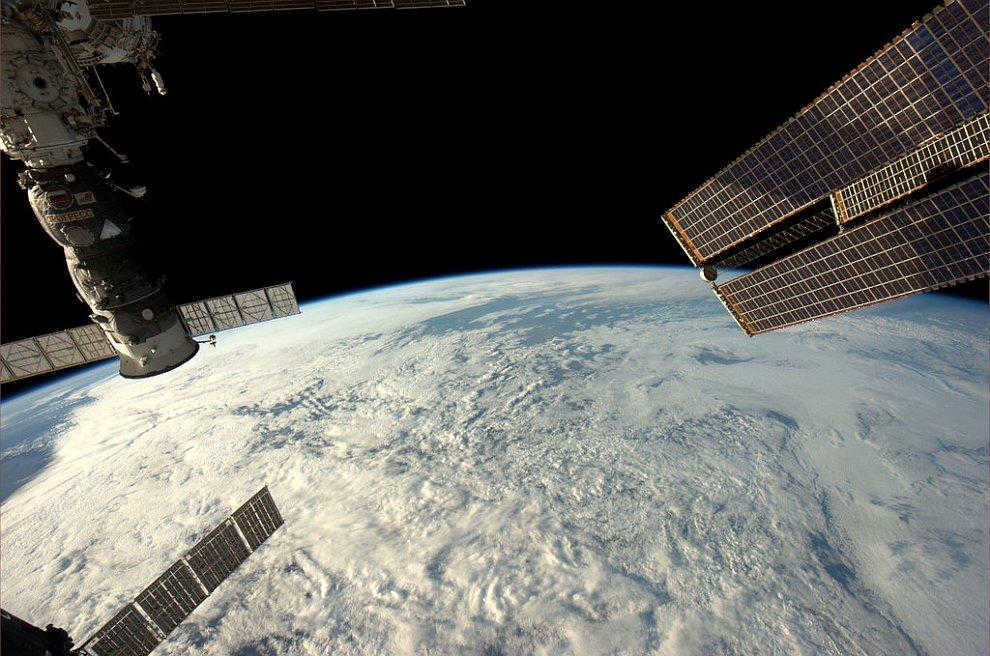
The acceleration due to gravity is 9.780327 m/s². In order to enter Earth’s orbit, an object must achieve a velocity of 7.91 km/s and 11.186 km/s to overcome its gravitational pull.
Geographers divide the Earth’s surface into various hemispheres. The equator serves as the boundary between the Northern and Southern hemispheres, while the 180th meridian and the Greenwich meridian separate the Eastern and Western hemispheres, respectively.
Scientists classify the Earth into distinct layers or geospheres:
Occasionally distinct from the lithosphere or the planet’s solid shell, the pyrosphere is situated beneath the Earth’s crust and is distinguished by elevated temperatures and melted substances. The core of the Earth, positioned at the planet’s exact center, is regarded as a distinct shell with its own exceptional composition and attributes.
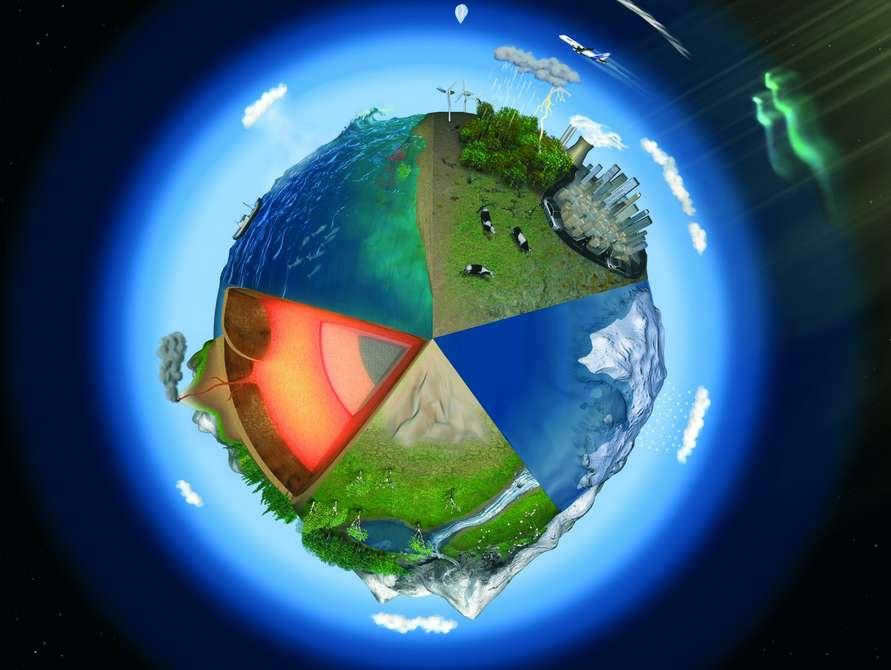
The Formation of Earth: A Journey Through Time
The Earth and the rest of the solar system came into existence around 4.5 billion years ago when a vast cloud of interstellar dust and gas collapsed. This cloud contained hydrogen and helium remnants from the Big Bang, as well as heavier elements forged through the explosion of dying stars.
Through the combined forces of inertia and gravity, this cloud gradually compressed, giving rise to the first planets in our solar system, including our very own Earth. Scientists estimate that the Earth took tens of millions of years to fully form. It is believed that the Moon, too, came into existence later on as a result of a powerful collision between Earth and another celestial body of significant size.
In those days, our planet was surrounded by an immense number of tiny celestial objects that incessantly bombarded its surface, causing it to heat up and also causing the protoplanet to grow in size. The temperature of the early Earth was sufficiently high to melt metals and minerals, with the heavier ones sinking and resulting in a lighter crust and a denser core. Initially, the surface of the Earth was a vast ocean of molten magma, reaching depths of several kilometers. The elevated surface temperature was sustained for a long time by the decay of radioactive elements like uranium and thorium.
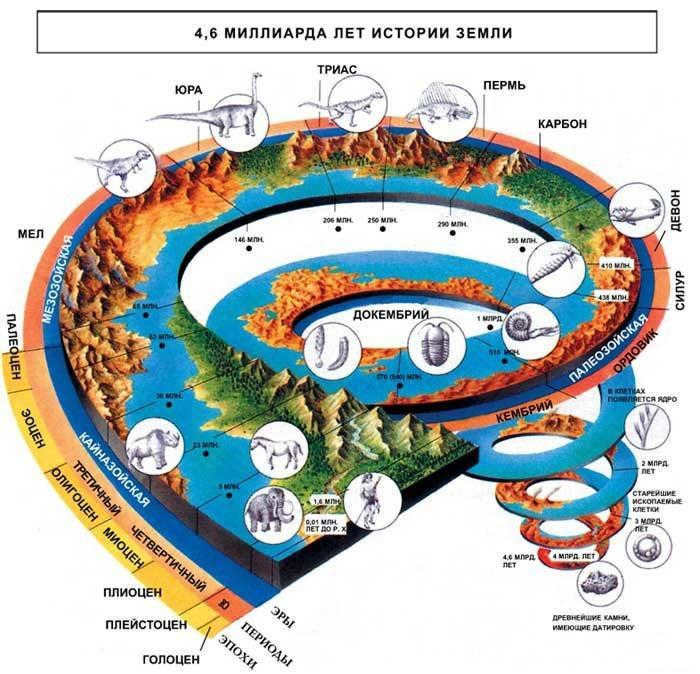
The initial atmosphere of the newly formed planet was composed of volcanic gases, and it gradually cooled down. Around 4.4 billion years ago, a significant portion of the planet’s surface had already solidified into a crust and water had emerged on it. Over time, the Earth transformed into a water-dominated world: by four billion years ago, approximately 90% of its surface was covered by the primary ocean. However, this environment was far from being comfortable and hospitable: the atmosphere primarily consisted of carbon dioxide, with temperatures reaching 200°C and atmospheric pressure so immense that it would easily crush a human being.
We enjoy reiterating the phrase: “Our blue planet Earth”, however, the origin of such a vast quantity of water on the planet remains perplexing. This is just one of the countless enigmas surrounding our planet. The question of where the water came from is crucial in understanding the beginnings of life, yet the debate surrounding it shows no signs of abating. Numerous theories exist regarding the formation of water on Earth. According to one theory, water was delivered to our planet by asteroids and meteorites that rained down upon its surface billions of years ago. Geophysicists propose that water originated on Earth through chemical processes occurring within its core. These two hypotheses are not mutually exclusive; it is conceivable that some water arrived from space via asteroids, while the rest was formed locally.
3 billion. 400 million years ago, the emergence of the first continents from the ocean gave rise to new land masses. The formation of granite, a type of rock created by volcanic eruptions, became the foundation of the Earth’s continental crust. This marked the end of the era dominated by the oceans and ushered in a new era dominated by land.
Accompanying the formation of the first continents were warm and sunlit shoals in the oceans, which served as the nurturing grounds for life on Earth. Presently, there are multiple theories attempting to explain the exact process by which life originated, but scientists have yet to reach a consensus. The origins of life remain one of the many mysteries of our planet.
The original inhabitants of our planet were simple prokaryotic organisms that did not have the ability to perform photosynthesis. Later on, cyanobacteria, the first organisms capable of photosynthesis, emerged along the coastlines and started to gradually fill the atmosphere with oxygen. According to scientists, life on Earth originated approximately 3.5-3.9 billion years ago. It was around this time that the planet developed a magnetic field, which acted as a shield, protecting the atmosphere from the harmful effects of cosmic radiation.
Around 2 billion years ago, bacteria filled the ocean with oxygen, initially using it to oxidize vast amounts of dissolved iron. Eventually, this oxygen made its way into the atmosphere, transforming our planet. The once green oceans, now depleted of iron, turned blue, and the sky took on its characteristic blue hue. This significant change occurred approximately 1.5 billion years ago.
Around 1.1 billion years ago, the initial terrestrial supercontinent, Rodinia, came into existence. Its surface would have likely resembled the Sahara Desert as we know it today – a desolate and barren landscape devoid of any vegetation or signs of life. The formation of this continent resulted in the first and most extensive glaciation event in the history of our planet. Rodinia obstructed warm ocean currents from reaching the poles, causing the entire world to be engulfed in ice for millions of years. Temperatures plummeted to a bone-chilling -40 °C, and the ice covering the oceans reached a thickness of kilometers. This catastrophic event occurred approximately 750 million years ago, leading to the genuine devastation of planet Earth.
Volcanic activities caused the division of Rodinia and gradually raised the temperature of the planet. It is believed that the Earth emerged from its icy slumber only 580-560 million years ago. Despite the harsh conditions, single-celled organisms managed to survive, and their progress was not impeded. This marked the start of the Cambrian explosion.
This term is used to describe the significant increase in biodiversity that occurred approximately 550-540 million years ago. The Cambrian period holds a special significance in the history of life on Earth. It was during this time that many modern organisms emerged, with animals developing strong shells, eyesight, and teeth. The increase in atmospheric oxygen also resulted in the formation of a new ozone layer, providing vital protection against the sun’s harmful ultraviolet rays. This allowed for the exploration of land.
In the Ordovician period, life first began to venture onto land. Primitive lichens and some arthropods laid eggs along the shores. The Silurian period saw the emergence of vertebrate animals, which gained a significant evolutionary advantage with the development of a rigid backbone.
The land was actively conquered in the subsequent period, known as the Devonian. This era commenced 417 million years ago and marked the emergence of the first forests populated by primitive ferns and horsetails. Simultaneously, insects, forming a significant evolutionary branch derived from arthropods, rapidly proliferated across the globe. Additionally, the Devonian witnessed the initial foray of amphibians, specifically vertebrates, onto land. Towards the conclusion of this epoch, the first bony fish made their appearance in aquatic environments.
The Carboniferous era (354-290 million years ago) was a time when insects, amphibians, and large horsetails and ferns thrived. The climate during this period was extremely hot and humid, and the oxygen levels in the atmosphere were significantly higher than they are today. These conditions allowed for the development of enormous insects. It is believed that the Carboniferous era is responsible for the majority of the world’s coal and other fossil fuel deposits. However, this geologic period came to an end with a global glaciation event approximately 290 million years ago.
During the Permian period, which occurred approximately 290 to 248 million years ago, there was a significant shift in the Earth’s climate, leading to drier and cooler conditions. This period also saw a transition from amphibians to reptiles as the dominant creatures on land, and the emergence of the first coniferous plants. However, what truly distinguishes the Permian period is the immense extinction event that took place at its conclusion, resulting in the loss of approximately 95% of all species inhabiting the Earth’s surface and oceans. This catastrophic event is believed to have been triggered by a colossal eruption of trap rocks in what is now Siberia. The eruption transformed much of the region into a molten lava lake, with volcanic activity persisting for around 1 million years. This prolonged volcanic activity released vast amounts of gases into the atmosphere, leading to a volcanic winter and further contributing to the mass extinction.
The reason behind the colossal Permian eruption remains a mystery, one of the many enigmas of our planet. Nonetheless, this event had a profound impact on Earth, leading to the formation of a new supercontinent called Pangaea, a drastic change in the atmospheric gas composition, and a shift in climate.
The surviving creatures of this catastrophic event underwent remarkable evolutionary changes, giving rise to the awe-inspiring creatures known as dinosaurs. For 160 million years, these majestic creatures dominated our planet, conquering not only the land but also the water and air. Some dinosaurs reached astonishing sizes, weighing up to 150 tons and measuring 50 meters in length. Despite their immense proportions, dinosaurs ultimately succumbed to a new global catastrophe that originated from outer space.
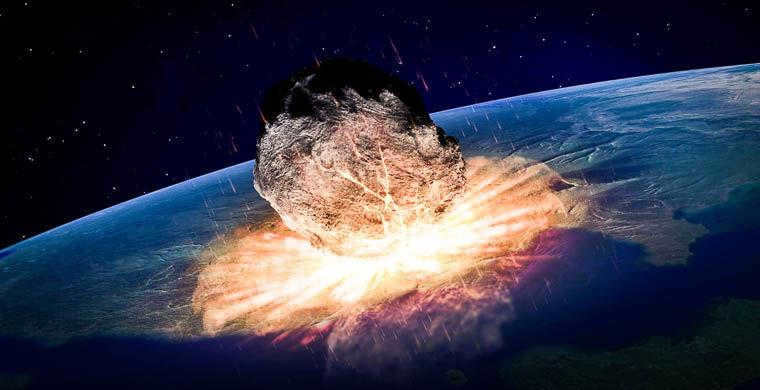
The debate regarding the reasons behind the extinction of colossal reptiles persists to this day, however, scientists primarily attribute it to the impact of a massive meteorite in the vicinity of the present-day Gulf of Mexico. This event resulted in a volcanic winter that lasted for numerous years and caused the demise of 70% of all organisms inhabiting the Earth.
The Earth’s air envelope: an overview
The Earth’s air envelope, also known as the atmosphere, is a crucial component of our planet’s geospheres. Composed of various gases, it encircles the Earth and extends into outer space. Not only does the atmosphere play a vital role in determining the climate and weather patterns on Earth, but it also creates the ideal conditions for life to thrive.
Defining the exact boundary of the atmosphere is a complex task. It gradually transitions into outer space, typically between altitudes of 500 to 1,000 kilometers. However, different organizations have varying perspectives on this matter. The International Aviation Federation sets the upper limit of the atmosphere at 100 kilometers, while NASA, the American space agency, considers it to be 122 kilometers.
The atmosphere of our planet Earth is composed of different gases and contaminants like dust, byproducts of combustion, water droplets, and ice crystals. The concentration of gases remains relatively stable, although there are some exceptions. One notable example is the industrial revolution, which has caused a continuous rise in the levels of carbon dioxide in the air.
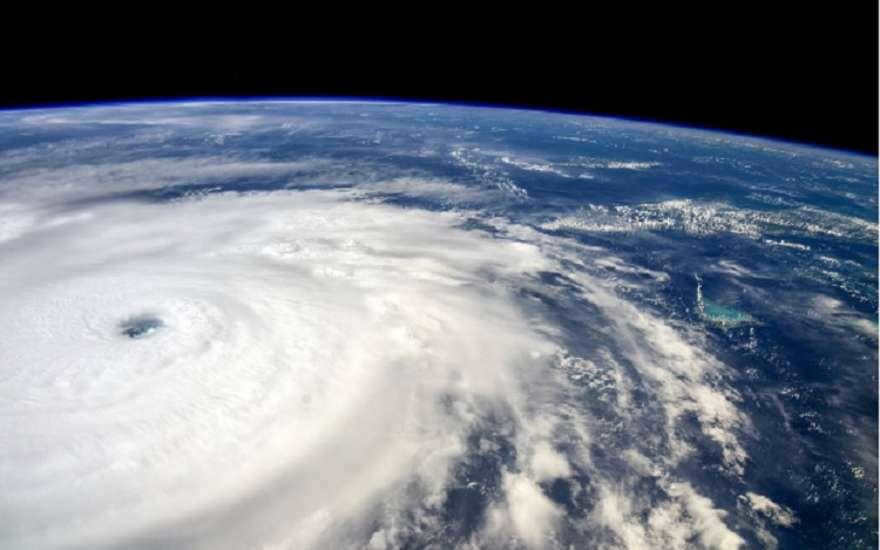

\
The majority of the atmosphere is composed of nitrogen, which accounts for over 78% of its composition. Oxygen makes up 20% of the atmosphere, while argon accounts for almost 1%. Carbon dioxide, methane, helium, xenon, hydrogen, and krypton make up the remaining 1%. The concentration of carbon dioxide is of particular importance, as it is a greenhouse gas that contributes to global warming. This is a significant issue that is currently plaguing humanity.
\
It is worth noting that Earth is the only planet with such a high concentration of oxygen in its atmosphere. Oxygen is both a byproduct of living organisms and a necessary element for sustaining life on our planet.
\
The Earth’s atmosphere is divided into the following layers:
Within these layers lie transitional zones that exhibit transitional characteristics.
The troposphere, the lowest layer of the atmosphere, serves as the home for all plants, animals, and the planet’s population. It spans from the Earth’s surface up to approximately 16-18 km in southern latitudes. The majority of the air and water vapor are found within this layer.
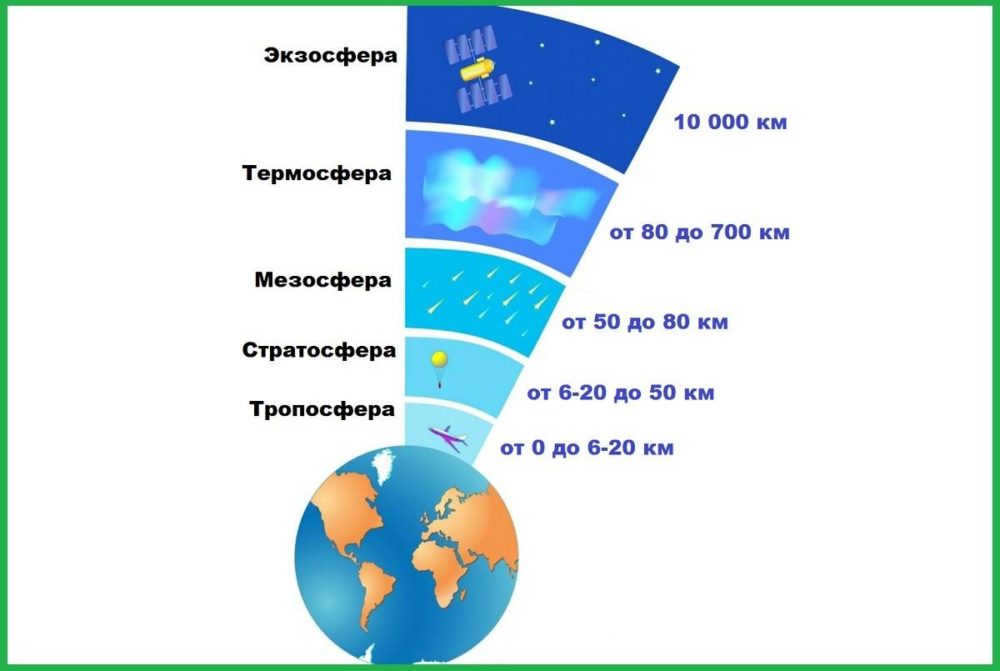
The stratosphere commences at an altitude of 16-20 km and extends up to 50 km. Many commercial aircraft operate within this region, and it also contains a unique ozone layer that shields all life on Earth from harmful solar ultraviolet radiation.
At an elevation of 50 km, the mesosphere begins and reaches up to 80 km.
Between 80 and 700 km lies the thermosphere, which includes the Karman line, the internationally recognized boundary between Earth’s atmosphere and outer space. This line is situated at an altitude of 100 km.
The hydrosphere is the liquid layer of the Earth
The hydrosphere refers to the water envelope of our planet, encompassing the vast oceans, rivers, lakes, reservoirs, groundwater, and icy glaciers.
Out of all the known celestial bodies, Earth stands out with its abundance of water on its surface. The total volume of water on our planet amounts to a staggering 1.39 billion km3. The majority of this water (over 96%) resides in the seas and oceans, which cover approximately 71% of Earth’s surface. The average depth of the World Ocean is around 3.8 thousand meters, with the Mariana Trench being recognized as its deepest point, plunging down to 10,994 meters.

Interestingly enough, the amount of fresh water available on land’s surface accounts for a mere 0.02% of the total reserves in the hydrosphere, making its scarcity one of the most pressing global issues of our time.
Water undergoes a complex cycle, moving from one part of the hydrosphere to another, with the involvement of other geological environments on our planet such as the atmosphere, lithosphere, and biosphere.
The strong outer layer of planet Earth
The interior of our planet possesses a complex arrangement, composed of a robust crust, a thick and fluid mantle, and an incredibly dense core. Moreover, geologists identify several distinct layers:
The lithosphere serves as the sturdy outer shell of Earth, encompassing both the crust and the upper portion of the mantle up to the asthenosphere. There exist two variations of lithosphere: continental and oceanic. The latter possesses a relatively insignificant thickness, measuring only 5-10 km, while the continental crust extends beneath the surface for 80-100 km.
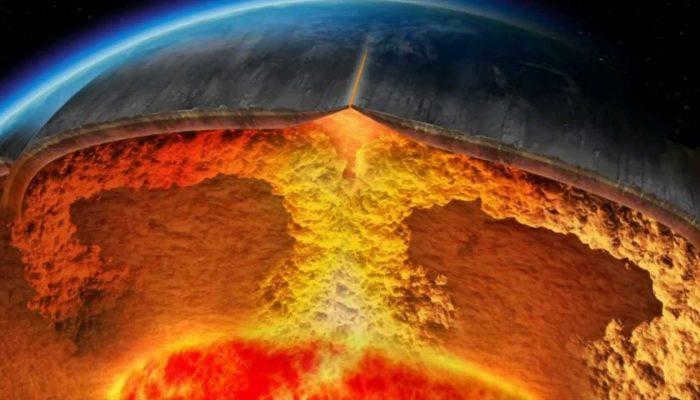
The lithosphere is composed of lithospheric plates that interlock like puzzle pieces. These plates are in constant motion, leading to the phenomenon of continental drift. This process is a result of tectonic activity, which includes volcanic eruptions, earthquakes, and the formation of mountains.
The asthenosphere, located at the boundary between the mantle and lithosphere, is a plastic layer that allows for the movement of lithospheric plates. Similar to the mesosphere, it forms part of the Earth’s mantle. The high temperatures and immense pressure in the mantle cause rocks to become plastic, facilitating continuous convection currents from the core to the crust.
Regrettably, there is limited and accurate data available concerning the processes taking place within the Earth’s interior. The deepest wells that have been drilled by humans only manage to reach a mere 15 km, which is minuscule in comparison to the thousands of kilometers that make up the Earth’s circumference. Due to obvious constraints, it is not possible to directly send research vehicles and equipment deep into the Earth, thus scientists must rely on indirect information.
Situated at the very core of our planet lies a highly dense and intensely hot center comprised of nickel, iron, and other dense elements. Presently, scientists differentiate between the outer liquid core and the inner solid core. The temperature at the core’s center can reach up to 6000 °C, which is slightly lower than that of the Sun’s surface.
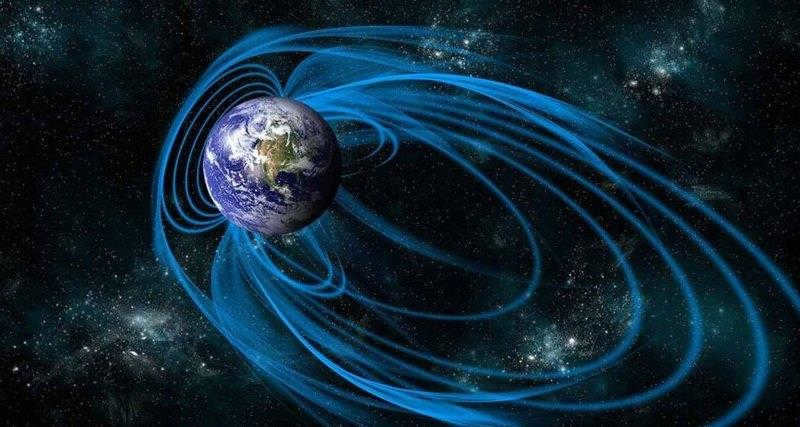
An important function of the core is the generation of the Earth’s magnetic field, which serves as a shield against harmful solar radiation. Essentially, the Earth can be thought of as a massive magnet with two poles. In contrast, Mars lacks a magnetic field, and as a result, its atmosphere has been gradually eroded by the solar wind over millions of years, rendering the planet barren. Scientists believe that this is one of the primary factors contributing to the absence of life on the red planet.
The biosphere: Earth’s Living Shell
The biosphere encompasses the planet’s shell, housing a diverse range of living organisms. This term refers to the global ecosystem on Earth. It is the specific portion of our planet that is home to various life forms and is influenced by their metabolic byproducts.
Also known as the “film of life,” the biosphere perfectly captures the distribution and scale of this interconnected system. It acts as a delicate film that covers the intersection of the atmosphere, hydrosphere, and lithosphere. Despite its thinness, the biosphere plays a vital role in shaping our planet. Since the earliest existence of life, organisms have been instrumental in transforming Earth. The biosphere serves as a significant geological force.

At present, the Earth is home to over 3 million different species, including plants, animals, microorganisms, fungi, and algae. Humans are also included in this diverse ecosystem, but their economic impact has far surpassed that of any other living organism. With a global population of approximately 7.5 billion people, human activity has extended beyond the boundaries of the natural world.
The upper limit of the biosphere is commonly defined as an altitude between 15 and 20 kilometers. Beyond this point in the atmosphere, organisms are rarely found due to the harsh conditions including low temperatures, thin air, and high levels of ultraviolet radiation. In the lithosphere, life is limited to a depth of approximately 5-7 kilometers, where the main challenges are high temperature and pressure. Nevertheless, there are a few “extremophiles” that can survive at such depths, although most organisms prefer the upper layer of soil. In the hydrosphere, life has managed to thrive even in the darkest depths of the World Ocean. However, the majority of the ocean’s biomass is concentrated in its upper layers, where there is an abundance of sunlight and oxygen.
The biosphere plays an active role in the cycling of substances and energy flows within nature. The energy from the Sun is received by the Earth and is partially absorbed by plants and other organisms that undergo photosynthesis. Over time, a portion of this energy is stored in peat, coal, and oil, while some is used in the weathering of rocks and the formation of sedimentary rocks. Living organisms also play a crucial role in the cycling of CO2, H2O, O2, and various other chemical elements. One notable example of the influence of living organisms on non-living matter is the formation of soil, which involves the participation of microorganisms, animals, plants, and fungi.
Human impact on the biosphere is significant. Each year, the population continues to grow, necessitating more resources and new areas for habitation, agriculture, and industry. As a result, forests are being destroyed, steppes are being plowed, and swamps are being drained. This encroachment on nature is rapidly reducing species diversity, and the waste generated by our economic activities is polluting the air, soil, and water. Not only does this situation lead to the destruction of ecosystems, but it also contributes to climate change, which can have catastrophic consequences.

